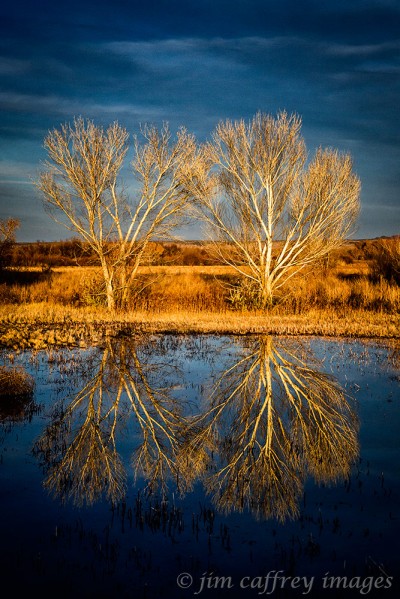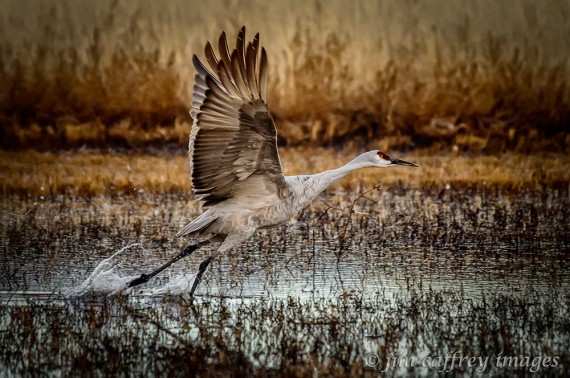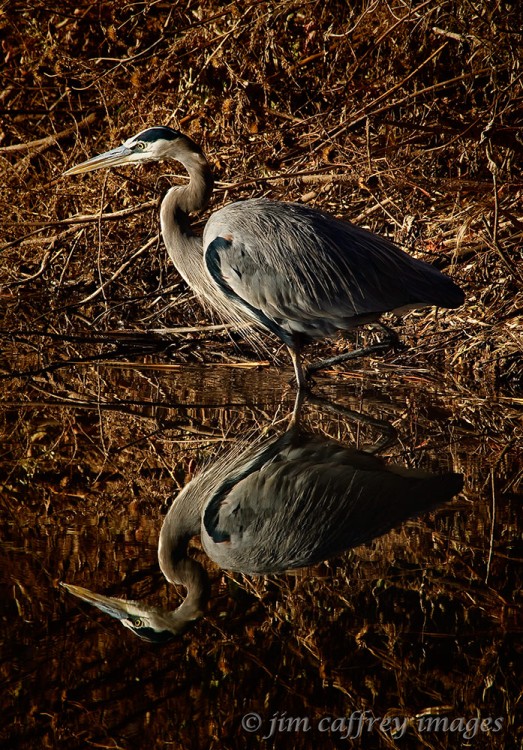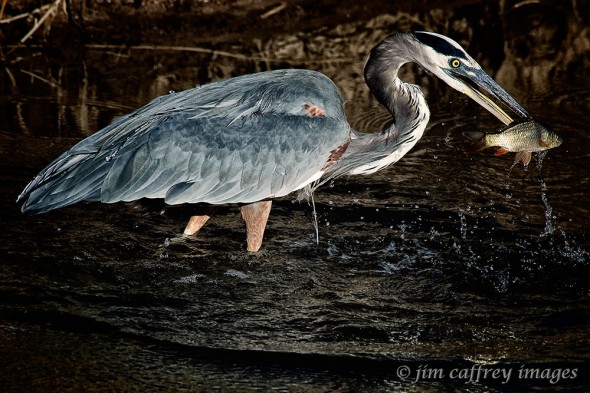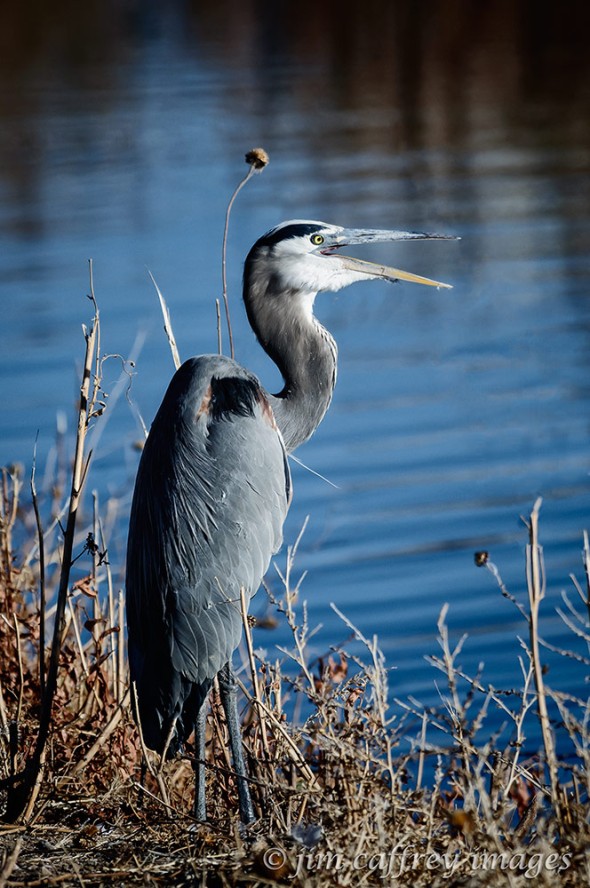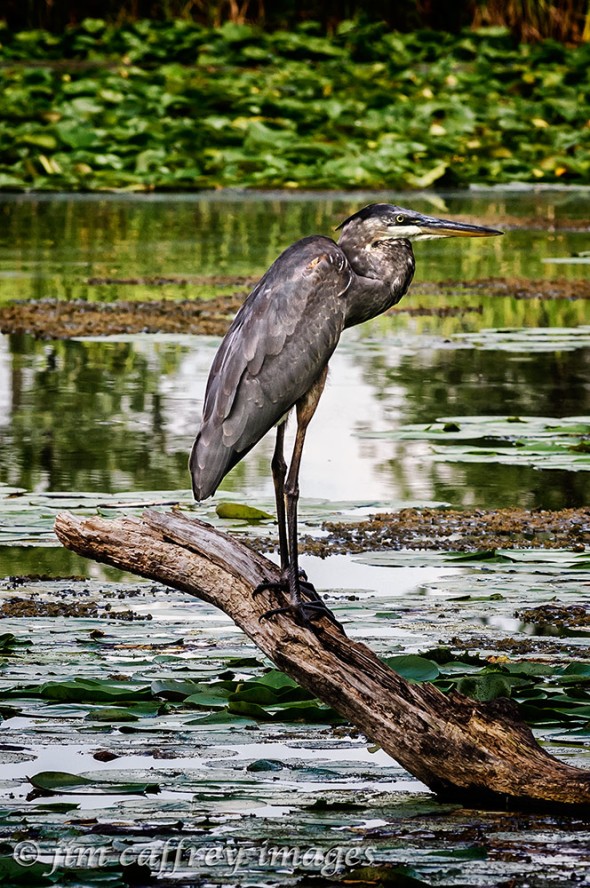Herons!
I admire herons, they are solitary hunters, they mostly keep to themselves, and they are are quick to depart when something, or someone encroaches on their space.
 I was photographing in the Bolsa Chica Wildlife Refuge near Huntington Beach, California when I saw this great blue perched atop a snag at a considerable distance from me. I grabbed my 600 mm lens and made several photographs. I like the way his guard feathers are moving as he turned his head
I was photographing in the Bolsa Chica Wildlife Refuge near Huntington Beach, California when I saw this great blue perched atop a snag at a considerable distance from me. I grabbed my 600 mm lens and made several photographs. I like the way his guard feathers are moving as he turned his head
 This small pond at Bosque del Apache is usually crowded with cormorants, but on this day there was just this great blue heron hunting for a meal. It was a calm day, so there were hardly any ripples on the pond, which meant near perfect reflections. I stayed for a long time making photographs and this one was the best.
This small pond at Bosque del Apache is usually crowded with cormorants, but on this day there was just this great blue heron hunting for a meal. It was a calm day, so there were hardly any ripples on the pond, which meant near perfect reflections. I stayed for a long time making photographs and this one was the best.
 This heron was perched along the edge of a dranage canal at Bosque del Apache in late December. It was a cold day and he was huddled against the frigid wind.
This heron was perched along the edge of a dranage canal at Bosque del Apache in late December. It was a cold day and he was huddled against the frigid wind.
 I mentioned earlier that herons are usually pretty skittish and fly off if you try to approach them, but I’ve rarely had that happen at Bosque del Apache. It’s as if they know they are in a safe environment.
I mentioned earlier that herons are usually pretty skittish and fly off if you try to approach them, but I’ve rarely had that happen at Bosque del Apache. It’s as if they know they are in a safe environment.
 These last two images are part of a series made over more than an hour while I watched this great blue heron hunting for his lunch. I made more than fifty photographs during that time, but these two tell the story pretty well I think.
These last two images are part of a series made over more than an hour while I watched this great blue heron hunting for his lunch. I made more than fifty photographs during that time, but these two tell the story pretty well I think.
Outdoor Photographer Interview
I was recently interviewed by Outdoor Photographer magazine about Bosque del Apache National Wildlife Refuge as a Photography destination. It is my first time being published in a major publication, so I’m pretty psyched about it. To read the interview click this link.
Many of you probably know that I make a trip (pilgrimage is more like it) every year in November or December to photograph the cranes, herons, and other waterfowl that inhabit the refuge during the winter months.

A Great Blue Heron catches his breakfast in one of the many diversion channels at Bosque del Apache NWR.
Most of you have probably seen these images before too. But, I thought I would re-post some of my favorites that weren’t included in the article.
For those of you who would like to visit Bosque del Apache, it is located about twenty miles south of Socorro, New Mexico on state road 1. And, once again, if you would like to read the interview, click here.
Bosque del Apache (A Wider View)
I love my Nikkor 80-400mm lens. On a crop sensor camera like my Nikon D300, I can get the effective reach of a much more expensive 600mm lens–albeit with a stop less light. The 80-400/D300 is my lens/camera combination of choice for photographing wildlife; I rarely use my full frame cameras and wide angle lenses while I’m at Bosque del Apache–at least not while photographing the birds. But, in a deliberate attempt to step out of my box, I have lately been making some wider angle photographs of birds, and I have been pleasantly surprised by the results.
My choice of the longer lens and crop sensor camera is driven by that combination’s ability to get in close and isolate the birds. By stepping back a little and capturing the wider view, I am trading the up close and personal frame for the more inclusive approach, which, I think, makes a more informative image. It puts the action in context.
Of course, this doesn’t mean that I will stop photographing these birds in an intimate context, the wider view is just a different way of approaching the subject, of telling the story.
If you were to go through this blog’s archives and read all the posts about Bosque del Apache, I doubt you would find very many, if any, of these kinds of photographs. So, it is my intention to give you a better overall idea of the scope of the experience.
One of my favorite things about a trip to the refuge is standing near a large flock of geese when they suddenly, in unison, explode into flight. The first image is my attempt to convey that feeling of synchronized confusion that accompanies these abrupt incidents. The geese will also land as a flock, but they are more relaxed in their approach so a few may land at one time, followed by a few more, until they have all touched down.
The Sandhill Cranes, on the other hand generally take off and land in pairs or small groups of two or three. Cranes are monogamous and will keep the same mate until one of them dies. They also move from one place to another in pairs or as an extended family group.

A group of Sandhill Cranes wade in the icy waters while two of their brethren take to the sky in search of breakfast.
Before I began photographing them, I never paid much attention to the habits of birds, but the more I watch them, the more interested I have become in their habits and their lives. Some of these habits can be very useful to a photographer. For instance, when they lean forward with their gaze fixed, it means that take off is imminent, so an informed photographer can be ready when the action begins.
Cranes are gangly creatures. When they approach a landing, they look like marionettes dangling from a string. Their long, spindly legs are improbable supports for their frames and their activities. But there is a certain majestic aplomb and zen-like intensity with which they carry out these movements that negates the clumsiness.
Over the years I have developed a kind of schedule for photographing at the Bosque. I usually get to the pond early, just before sunrise and then spend several hours with the cranes as they awaken and fly off to the fields for the day. Afterwards, I drive around the tour loops in the refuge looking for anything that may catch my eye. This is usually when I catch a heron hunting for his breakfast. I realize that this image is a departure from the subject of this article, but this really is the best way to tell the story about the herons. They do nest in groups at night, but their daytime existence is a solitary one. They wade through the shallows looking for a meal, and then move on in search of the next one.
It’s also during these drives around the refuge that I come across scenes like this: hundreds of geese floating placidly in a pond, drowsing, or grooming themselves. Then suddenly and without warning they explode in a cacophony of sound and motion.
Of course, there are other kinds of wildlife besides birds to be found at the refuge. bobcats, coyotes, mountain lions, javelinas, and many others make Bosque del Apache their home. As we were driving toward the exit we came across this young mule deer buck calmly strolling through one of the ponds along the connector road. The two mallards swimming in the opposite direction seemed un-fazed, but stayed on their side of the road.
Bosque del Apache is located about twenty miles south of Socorro, New Mexico along the Rio Grande. I would highly recommend it as a stop on your next visit to New Mexico. If you are a photographer, and you want to isolate the birds, a long telephoto (at least 400mm) is recommend, but as this entry makes clear (I hope), you can make some great images with a shorter lens as well. The best time of year to visit if you want to see the cranes and geese is November through February, but the refuge is open year round and many of the birds and other wildlife make Bosque del Apache their home year-round.
Bosque Annual
This is actually old news; the images in this post were made in November. Other things have come and intervened and gone, so I am catching up with the past. One thing about photographing at Bosque del Apache: you never know what you’ll come away with.
Last year (2012) it was cold at sunrise; it took nearly four hours for all the birds to leave the pond. This year was different, with the temperatures barely below freezing, they were off the pond in less than two hours. So, things were happening pretty fast. These two sandhill cranes are in the process of taking off from the Chupadera Pond.
On the first evening, we photographed the fly in from the Flight Deck Pond. While we were waiting for the birds to arrive, I noticed these trees near the pond being lit by the setting sun. The water was still and smooth as glass. Another rorschach image.
I am a creature of habit I suppose. I have a routine that I follow while at the Bosque. When the morning fly out is over, I take a leisurely drive around both tour loops just to see what I can see. It’s on this drive that I usually find the herons, and this year I was not disappointed. I made this image of one catching his morning meal in the diversion channel on the west side of the refuge.
After crossing to the east side at the southern end of the loop, we came across this idyllic scene. The San Mateo Mountains provided just the right background the heron in the foreground was an added bonus.
These final images pretty much sum up the reasons I make my annual sojourn to Bosque del Apache: sandhill cranes and great blue herons.
They live in the wild, but at places like the Bosque where they are protected, we can rub elbows with them and catch a glimpse into their lives. I can’t imagine a life without a connection to such untamed beauty.
Herons, Herons and More Herons
Herons are solitary birds. Unlike cranes that go about their business in large flocks, herons are found on the edge of things: walking slowly and quietly along a canal, drainage ditch or river, hunting for their dinner. Although they are monogamous, they are rarely seen out together in public.
When I make my annual pilgrimage to Bosque del Apache National Wildlife Refuge, the skies and the ponds are filled with raucous, gangly, yet somehow graceful cranes–thousands of them. The typical heron count is three or four. So, I spend a fair amount of time cruising slowly along the drainage canals looking for these elusive birds.
Sometimes, when I’m patient, I’m rewarded with a capture like the one above. I had followed this guy (girl?) for close to half an hour, moving when he moved, but giving him plenty of room. When I saw him extend his neck, I fired a continuous burst of about five exposures and this is the result.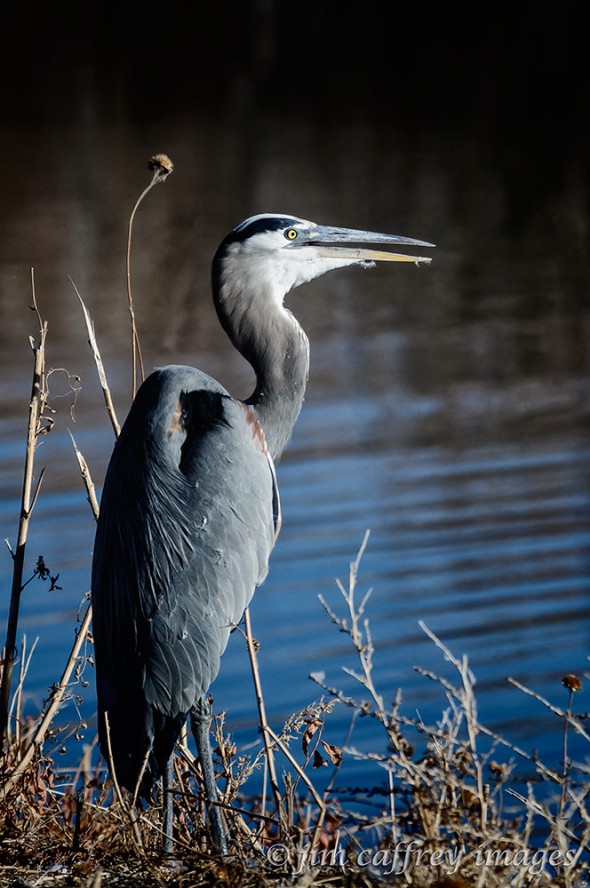
There are other times when patience has nothing to do with it. Robin and I came across this heron standing along the edge of a canal on the south side of the Flight Deck Pond. We were easily within twenty-five yards of him and he acted like we weren’t even there.
Every once in a while, he would close his eyes as if napping. After about thirty minutes we had gotten all the exposures we wanted and drove off leaving him standing there.
I made this last image while my daughter Lauren and I were walking her dog at a dog park in Madison, Wisconsin. Luckily, I was a little ahead of them and had time to warn her off. Otherwise, her dog would have been after the bird and this capture would have been lost.
More Flying On The Ground
I made my annual “pilgrimage” to Bosque del Apache National Wildlife Refuge last weekend. I came home with well over fifteen hundred images to work through. I’m not finished, but I do have some “keepers” from the first batch of processing.
The first image was captured early on Saturday morning at the North Chupadera Pond along Highway 1. I was looking for a full wing shot, but was having trouble catching one.
I have a pattern that I follow while at The Bosque in order to optimize my interaction with the birds. After the cranes have all flown off from the ponds where they spend the night, I drive the entire loop looking for whatever might be there. I can usually find a Great Blue Heron along the edge of one of the channels that run through the refuge, and this year was no exception. This one seemed to be dozing off and on while waiting for his breakfast to appear.
There was certainly no shortage of take-off images. The cranes signal their intention to get airborne by leaning forward and stretching their necks as if they are testing the wind (perhaps they are). If you are a photographer waiting for some action, this should be a heads up that things are about to get interesting.
I captured both of these images as the cranes were running to reach the speed they need to take off. The movement in these images is horizontal and normally calls for a landscape orientation, but when I took the second photo, I was looking for something specific which would be better served by a portrait orientation.
My patience was rewarded when this lone crane spread his wings. The reflection was a bonus.
Stepping Out Of My Box
When I go on a photo expedition or lead a tour, I take two cameras and all the lenses I could possibly need, all packed into my Lowepro AW 300 Trekker backpack with my tripod strapped to the outside. It’s a load and can sometimes become a bit much after trekking through the desert all day. But, I do it because I know I’ll have whatever I need to capture the images that I see.
Recently, I flew to Madison, Wisconsin to visit my lovely daughter Lauren. The baggage and carry-on restrictions prevented me from bringing along all of my gear, so I made the trip with one camera, two lenses, and a flash packed into a shoulder bag. As a result, I was forced to look at my photography in a whole new way, and I am quite pleased with the images I brought home.
I made this portrait of Lauren on one of our early morning dog walks. If you knew Lauren as I do, you would also know that this is the perfect setting for a portrait of her.
I made this image at Lake Mendota, the bigger of the two lakes which border Madison on the north and south. This gull was walking up and down the pier like a miniature Charley Chaplin. It was pretty comical and I made close to forty exposures of him, but when he stopped and looked over the edge, he provided the perfect counterpoint to the fisherman.
Believe it or not, this image was made in one of Madison’s many dog parks. This one has its own wetlands complete with a green heron. Luckily, I spotted the bird before Lauren’s dog did.
This last image is of a lotus flower and lily pads in the Japanese Garden at House On The Rock in southwestern Wisconsin. House On The Rock is an amazing place and deserves more than just a nod in a photography blog. If you’re ever in that part of the world, I highly recommend the tour.
So, aside from spending a wonderful week with one of my favorite people, this trip also forced me to look at my work in a different way. Art, like anything else in life, needs to evolve; otherwise it stagnates and looses its appeal.
Bosque del Apache
This was the scene at the farm fields at the north end of the Bosque del Apache NWR on Saturday morning. It is fairly typical for this time of year. Most of the birds have arrived for their winter stay at the refuge. On this particular morning there were 9,527 sandhill cranes, over 40,000 snow and Ross’s geese, 3 bald eagles, and over 300,000 ducks of various species. There were also innumerable LBBs (little brown birds), and an unknown number of deer, coyotes, bear, and other mammals. Oh yeah, and at least one mountain lion (one trail was closed due to recent lion sightings). All in all, a pretty respectable showing.
We had arrived the previous evening, and spent a couple hours on the “Flight Deck” watching and photographing the cranes flying back from the fields which surround the refuge to spend the night in the ponds where they are relatively safe from the predators (mostly coyotes) which are numerous in the Bosque. We were up and out the door at 5:30 in order to make it to the reserve for sunrise. It was cold–around 10°F, but there were at least twenty other photographers gathered at the edge of the Chupadera pond. I set up my tripod, and joined in the fun. As the sun rose, the cranes began to stir, and the cameras began to whir. I was suddenly reminded of the cold when my camera began to respond sluggishly, then stopped working. The shutter had frozen. I stood there helplessly while the birds took off and everyone around me continued to shoot. I’m not sure why mine was the only camera to succumb to the frigid temperatures, but I stubbornly tried, and tried again, to get the thing working even though I had another camera in the car not fifty yards away. I’ll have to work on that!
So, while I was busy trying to keep my camera working, Robin was next to me happily snapping away. She made this image just as the sun was starting to warm the scene with it’s golden light. Cranes go through a ritual before taking off. This one was stretching his wings in preparation for his first flight of the day.. The two birds on the right are just beginning the next stage: they face into the wind and stretch their necks, leaning forward. I think what they are doing is testing the wind, getting an idea of how they will get themselves into the air. This behavior is a signal to a photographer to be ready because take off is imminent. Well, any photographer with a working camera.
Next we headed into the refuge and turned south to drive the marsh loop. I was still toying with my camera and was happy to find that it was working again after thawing out. I had heard horror stories about shutters breaking after being frozen. It was shortly after this that Robin spotted this Great Blue Heron in the ditch on the west side of the road.
We stopped and spent about twenty minutes photographing him. He just stayed where he was, going about his business while keeping one eye on us. He finally spread his wings and flew off, and we packed up our gear and drove off, but we didn’t go far. About two hundred yards down the road, we came across hundreds of geese. They were in the marsh, and they would fly across the road to the field on the opposite side to eat, and then fly back across the road to the marsh. We spent quite a while watching them. Robin got the best photo.
The four geese on the left are Snow Geese, and the highest one is a Ross’s Goose. Collectively they are referred to as Light Geese. These five were flying to the field from the marsh.
We continued around the marsh loop, and on to the farm loop. We had just passed the Coyote Deck when we spotted several cranes flying low. We pulled over just as they landed on a berm between us and the flooded field beyond. This is one of them that seemed intent on watching us while the others went about their business. Perhaps he was the designated sentinel for the day.
Before we completed the farm loop, we made a stop at the Flight Deck to see if there was any activity there. Not surprisingly, there were no cranes or geese in evidence. There was, however, a lone bald eagle perched in “the tree” which stands out in the large pond in front of the Flight Deck. He spent quite a long time surveying his domain before taking wing to patrol the remainder of the refuge.
Bosque del Apache is undoubtedly a special place. I never tire of going there. The scenery combined with the thrill of seeing thousands of waterfowl and numerous raptors in one place at one time makes for a memorable trip.














